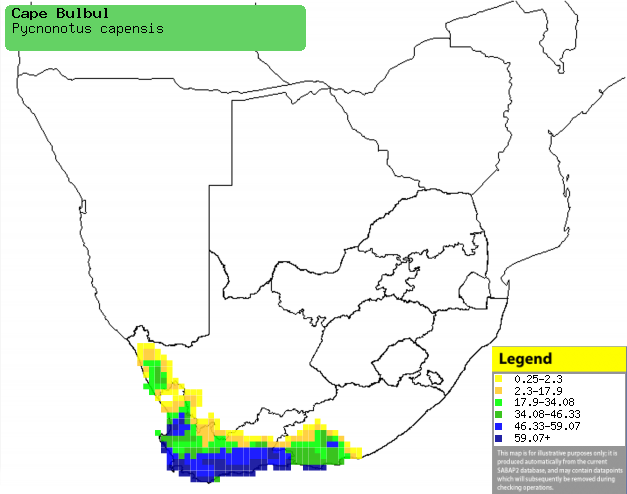|
Pycnonotus capensis (Cape
bulbul)
Kaapse tiptol [Afrikaans]; Kaapse buulbuul [Dutch];
Bulbul du Cap [French]; Kapbülbül [German]; Tuta do Cabo [Portuguese]
Life
> Eukaryotes >
Opisthokonta
> Metazoa (animals) >
Bilateria >
Deuterostomia > Chordata >
Craniata > Vertebrata (vertebrates) > Gnathostomata (jawed
vertebrates) > Teleostomi (teleost fish) > Osteichthyes (bony fish) > Class:
Sarcopterygii (lobe-finned
fish) > Stegocephalia (terrestrial
vertebrates) > Tetrapoda
(four-legged vertebrates) > Reptiliomorpha > Amniota >
Reptilia (reptiles) >
Romeriida > Diapsida > Archosauromorpha > Archosauria >
Dinosauria
(dinosaurs) > Saurischia > Theropoda (bipedal predatory dinosaurs) >
Coelurosauria > Maniraptora > Aves
(birds) > Order: Passeriformes
> Family: Pycnonotidae
Distribution and habitat
Endemic to South Africa, where it is very common Across
much of the Western Cape, extending along the coast to the Northern and Eastern
Cape. It generally prefers thickly vegetated fynbos and succulent karoo, as well
as coastal scrub, Acacia karoo (Sweet thorn) woodland, suburban parks and
gardens.
|
 |
|
Distribution of Cape bulbul in southern Africa,
based on statistical smoothing of the records from first SA Bird Atlas
Project (©
Animal Demography unit, University of
Cape Town; smoothing by Birgit Erni and Francesca Little). Colours range
from dark blue (most common) through to yellow (least common).
See here for the latest distribution
from the SABAP2. |
Brood parasites
It has been recorded as host of the
Jacobin cuckoo.
Food
It mainly eats fruit, supplemented with arthropods, seeds
and nectar. It usually forages in pairs or small groups, plucking fruit from the
foliage of trees and bushes, while occasionally hawking invertebrate prey. The following food items have been recorded
in its diet:
- Fruit
- Rhus crenata (Dune crow-berry)
- Acacia cyclops (Rooikrans)
- Chrysanthemoides monilifera (Bushtick-berry)
- Rapanea gilliana (Dwarf cape beech)
- Nylandtia scoparia (Dune-berry)
- Seeds
- Nectar
- Arthropods
Breeding
- The nest is built solely by the female in about 2-10 days, while the male
watches intently. It consists of a sturdy but messy cup built of twigs,
grass stems and rootlets, built on a foundation of larger twigs and lined
with finer planter material. It is typically placed on a horizontal branch
near the edge of a bush's or tree's foliage.
- Egg-laying season is from August-March, peaking, peaking from
September-November.
- It lays 2-5 eggs, which are incubated solely by the female for about
11-13.5 days. It leaves the nest about 20-40 times a day to go foraging, in
fact it only spends about 60% of the day incubating.
- For the first few days the chicks are mainly fed arthropods, but
thereafter fruit dominates their diet. Both parents feed the chicks, who
leave the nest before they can fly, at about 10-13 days old. They fledge a
few days after leaving the nest, but remain dependent on their parents for
food for at least two weeks more after leaving. They eventually become fully
independent at about 50 days old, at which point they start to sing and
call.
Threats
Not threatened.
References
-
Hockey PAR, Dean WRJ and Ryan PG 2005. Roberts
- Birds of southern Africa, VIIth ed. The Trustees of the John Voelcker
Bird Book Fund, Cape Town.
|
